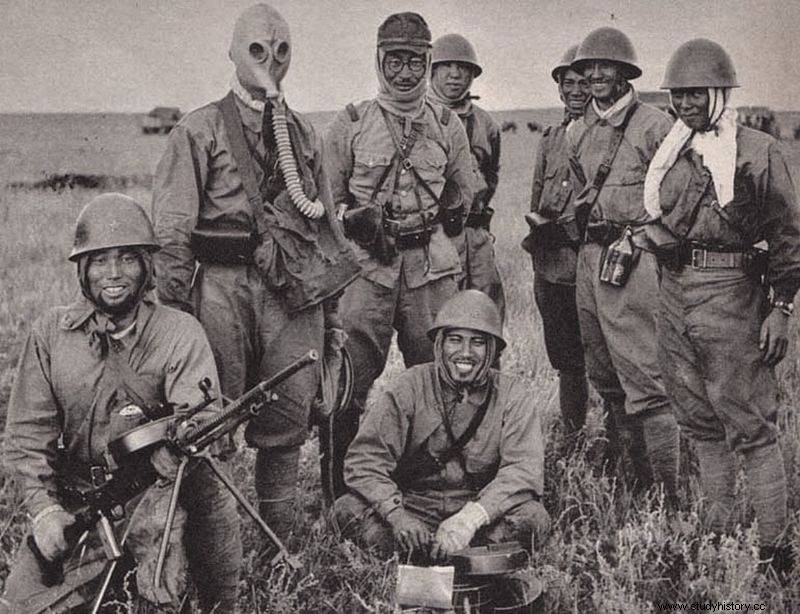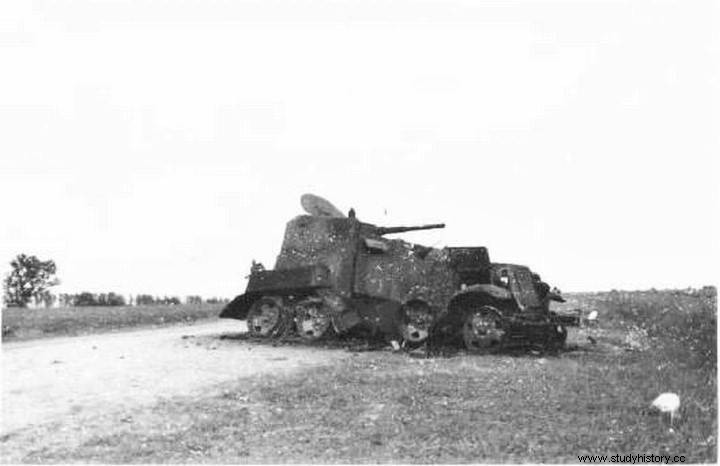Lack of recognition, lack of organization, total chaos - this is how the "invincible" Red Army fought. The pathetic embarrassments of the Soviet military before World War II should have alerted the command. The incredible losses in people and equipment, however, did not provoke any reflection.
We have already written about the disastrous conditions of military service and what a fiction was combat training in the Red Army. But what happened when these under-trained and under-educated soldiers went into battle?
Spanish lesson
The civil war in Spain was a testing ground for Soviet cadres. There, however, Soviet "volunteers" were doomed to cooperate with soldiers from other countries and it is difficult to assess their combat value. However, already then there were some signals that should give some food for thought to the Soviet decision-makers.
The Republican International Armored Regiment took part in the battle for the town of Fuentes de Ebro. It was armed with 48 BT-5 tanks, the crews of which consisted of Soviet "volunteers" and members of the International Brigade, trained at the Armored School. Gorky. The regiment was to capture the Fuentes de Ebro and thus open the way to Zaragoza.
The attack was scheduled at noon on October 13, 1937. The attack, however, was delayed. The tankers did not manage to reach the positions that were the basis for the strike because they had received their orders at 11 p.m. the previous day and it was about 50 kilometers to the designated areas.

Soviet T-26 tank during the Spanish Civil War (source:public domain).
To make matters worse, two hours before the action, the tank crews were informed that they would be carrying an infantry landing on their armor, which they had never practiced. There was also no diagnosis. The commanders had a vague idea of where the enemy was positioned, their forces, the amount of anti-tank weapons, or even the terrain on which the tanks were to charge!
The attack ended in a complete disaster. The BT-5 fired a volley of guns and fell to the attack. While crossing their own lines, the tanks were fired upon by their own infantry which no one had informed about the planned attack! Many "landing men" died then, others fell from their tanks, unable to hold on to the shaky armor.
When the BT-5s were in the open, they were massacred by the fire of hidden nationalist anti-tank cannons. The few infantry that remained with them could in no way provide them with proper cover or hold any occupied territory. The operation was aborted. The regiment lost nineteen tanks, several more were damaged.
Japanese lesson
Another test for the Red Army was the fight against the Japanese at Lake Chasan. The commanding cadre of the Soviet army absolutely wanted to demonstrate its successes in front of its commander. Soviet fighters struck Japanese positions on July 29, 1938 and seized disputed territory. The Japanese then went on to counterattack and threw the enemy back to the starting positions by July 31st.
It was one big mess and the lack of any organization on the part of the Red Army. There have been cases of artillery batteries reaching the front without missiles . Some infantry units did not have rifles and gas masks. The uniforms were also in a deplorable condition: many soldiers were sent to fight in completely worn shoes, almost barefoot, in uniforms so torn that they were actually in their underwear .
The situation was repeated from Spain. Reconnaissance was again neglected, and the attacks of different types of troops were in no way coordinated with each other. T-26 and BT tanks attacked in small groups, in unfamiliar territory, without artillery preparation and infantry support. This was for a simple reason: the rifle regiments did not have radio stations and the artillery fired from the maps and in no way kept up with the dynamics of the battlefield.
On August 10, at the initiative of the Japanese government, representatives of both warring sides sat down for talks. A day later, combat operations ceased and returned to the status quo from before the fighting in this area. Nevertheless, the Soviets declared themselves the winners and this was the message that went out to the world.

During the Russo-Japanese War, Red Army soldiers were certainly not so well uniformed and armed (source:public domain).
In fact, the Red Army suffered much greater losses in manpower and equipment than the Japanese army. Among other things, 96 tanks were lost. The Japanese did not lose any because they had no armored forces at all.
Especially the combat training of the Red Army officers was not very optimistic. Kliment Voroshilov himself later stated that the combat preparation of troops, staffs and the command-management team turned out to be at an unacceptably low level.
Chałchyn Goł
A year later, the fighting on the Khalkhyn Gol River, along the Mongolian-Manchurian border, was close to being discredited. The first skirmishes there began on May 11, 1939. On May 28, Japanese troops launched an offensive that the troops of the Soviet 57th Corps repelled.
The Japanese then retired their units, and numerous trucks were used in this operation. When Soviet intelligence reported this to the staff of the 57th Corps, the situation was misinterpreted and it was assumed that Japanese reinforcements had arrived! As a result, the Soviet-Mongolian troops occupying the bridgeheads on Chałchyn Gol were hastily ordered to cross the river back to save them from the expected attack by new Japanese units!
On June 5, Georgy Zhukov arrived with the staff of the 57th Corps with a group of commanders. As a result of crushing criticism on his part, the current commander of the corps, Komdiv Feklenka, was dismissed. Zhukov himself replaced him. The change did not bring any new great quality in command.

Soviet tank forges Chalchyn a goal. As you can see, it did not constitute any obstacle for the armored forces (photo:Wiktor Antonowicz Tiomin, public domain).
On July 3, under the very nose of the Soviet army, 13,000 Japanese soldiers and 100 guns imperceptibly forced their way through Khalkhyn Gol and fortified on Mount Bajan-Cagan, a high bluff on the west bank of the river. What were the recon and intelligence units doing at that time of the staff of the all-time Soviet strategist, later Marshal Zhukov, will probably remain a secret forever.
The Japanese troops were discovered in the morning by Colonel Afonin, an adviser to the "allied" Mongolian army, who was to inspect Soviet units in the area. The colonel, writes Władimir Bieszanow, unexpectedly discovered Japanese troops there . Of course, he did not fail to inform Comdiv Zhukov of his discovery.
Great success of Georgi Zhukov
He reacted extremely vigorously, in the Soviet way. Columns of Soviet tanks, without the support of infantry, artillery, having no idea about the forces and location of the enemy, attacked with all their might . About eighty out of 132 T-26s and BTs were burned or damaged. After them, at 1 p.m., a motorized infantry regiment struck. With a known effect.
At 3 p.m., fifty armored cars from the 7th Armored Brigade were charging beautifully. The red tankers entered the fight straight from the march, nobody took care to familiarize them with the situation on the battlefield . The effect of the attack as before - thirty-three wrecks of Soviet armored vehicles were left in the foreground, over eighty soldiers died.
The Japanese defended themselves there for two more days. At the end, skillfully, in an organized manner, taking heavy equipment at the same time, they withdrew through the crossing that the Soviet air force could not destroy for those two days.

Soviet armored car destroyed during the fights on Chałchyn-Goł
The Soviets finally won over Chałchyn Gol, but this was not the result of sophisticated tactical maneuvers, but a brutal quantitative advantage in armored equipment and aviation. Their losses were staggering anyway:they lost 253 tanks and 124 armored cars (over 200 more armored cars were damaged), around 28,000 soldiers were killed, wounded or missing.
Data on this subject was disclosed only in the 90s of the twentieth century. The Japanese then lost approximately 17,000 killed and wounded. The victory over Chałchyn Gol was not a reason for glory at all.
Final test
The clashes in Spain, or, to a much greater extent, with the Japanese forces proved that the Red Army is helpless on the battlefield. Virtually everything was malfunctioning:communications, reconnaissance, and supplies. Commanders of various levels were unable to coordinate the actions of different types of troops, as a result of which they acted independently, which in turn exposed them to high losses.
The higher charges lacked initiative, often paralyzed by fear of the omnipotent political commissioners who could send them in front of the firing squad with one telegram to Moscow. It took revenge later. The campaign in Poland was actually light, easy, and enjoyable, but only because our soldiers were ordered to avoid fighting the Soviet troops.
Virtually everywhere, where the Polish Army put up organized resistance, such as near Grodno, the Soviets suffered considerable losses. The winter war with the Finns in particular has ruthlessly exposed the weakness of the Red Army. The real test for the Soviet fighters began on June 22, 1941 with the attack of Germany on the USSR. It was then quite pitiful for the Red Army.
By the end of 1941, the Soviet army's loss of killed, wounded, missing and captured amounted to an unbelievable figure of about eight million! German losses did not exceed 831,000 soldiers at that time. The Soviet soldier was reduced to the level of cattle, sent en masse to slaughter.
